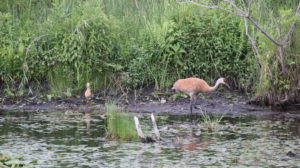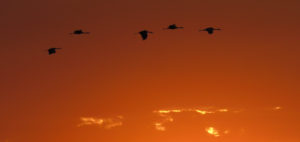Spying on Sandhill Cranes
by James Holtzclaw
I stepped out of my vehicle, looked around, and started exploring the trails at Boot Lake Nature Preserve. The trails cut through various ecosystems: grasslands, woodlands, and wetlands. The surrounding areas showed signs of the recent seasonal changes. The grasslands lost their fall flowers, the woodlands revealed their bare trees, with leaves littering the ground, and the wetlands contained less water. This natural setting was waiting for winter and its first snow.
As I meandered through this altered landscape, I listened to what sounded like trumpet sounds, which piqued my interest because they were familiar sounds from different times in my life. I followed these calls until I walked on a floating dock. There, I spied on hundreds of towering birds with rust-red, ashen plumage and their heads adorned with red caps and long beaks. I recognized them from my time in Tennessee as Sandhill Cranes. These ancient birds were foraging in Boot Lake’s mud flats, searching for seeds, berries, frogs, and fish while they waited for Mother Nature’s orders to fly south.

The Sandhill Cranes’ migration to the southern U.S. and northern Mexico most likely occurred before man migrated to North America. A Sandhill Crane’s fossil found in Florida indicated they were here about 2.5 million years ago. While I listened to their calls and watched them forage, I realized that their migration consisted of not just these few hundred birds at Boot Lake Nature Preserve but over five hundred thousand birds. In October, birders and naturalists looked into the heavens, listened for these birds’ calls, and tried to spot their V-formation.
As I stared at these feathered creatures at Boot Lake, I became homesick, and I could not help but imagine seeing them soar through the southern skies and stopping at Joe Wheeler National Wildlife Refuge near Huntsville, Alabama, and the Hiwassee Wildlife Refuge near Cleveland, Tennessee. Like Boot Lake Nature Preserve, these sites were havens to ensure that these great grey birds had a place to rest as they moved southward. They were established so that I could observe and celebrate these feathered creatures’ migration while living in Tennessee. I was here at Boot Lake, watching a few hundred before they took their first steps, or rather wing beats, of this journey. I realized they might fly over my past homes, and their present renters won’t run out of the front door to look up in the sky when they hear their trumpet calls, missing a connection to one of North America’s great natural events.

I considered my connection to the Sandhill Cranes in Tennessee to be one among a billion personal stories. I often wonder if you, the reader, have a story about these cranes. Maybe you saw them in the sky flying southward, spied on them at a refuge, or came upon them while canoeing the Elkhart River. Sandhill Cranes have always been part of our human stories. Some Native American tribes recognized them as a sign of promise, happiness, and a rebirth. As Lewis and Clark traveled westward, they mentioned the Sandhill Cranes in their journal entries. When I saw them in the past, I always pondered their existence with us. I concluded that Sandhill Cranes were entwined into our human stories and played a significant role in our cultural heritage. Their distinctive sounds echoed throughout our wetlands, and their graceful form begged us to understand their time here with us.
*photos by Annie Aguirre



